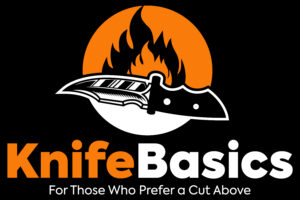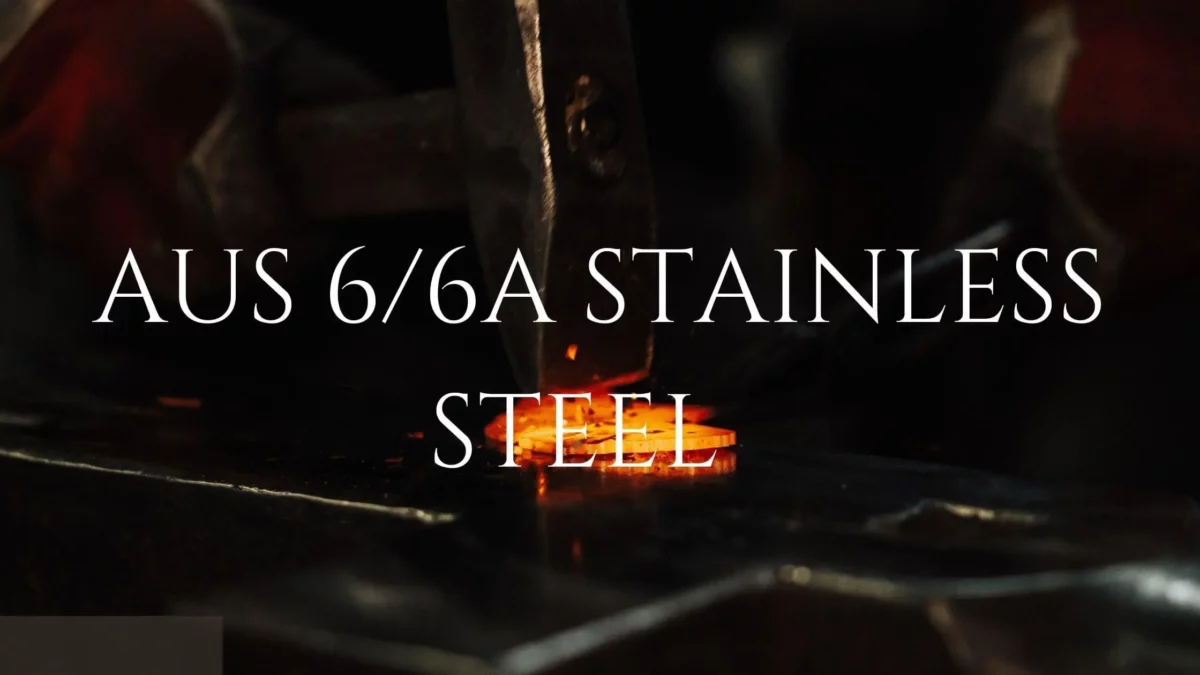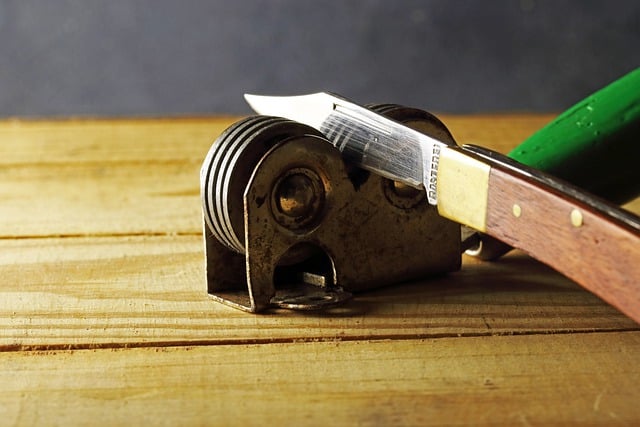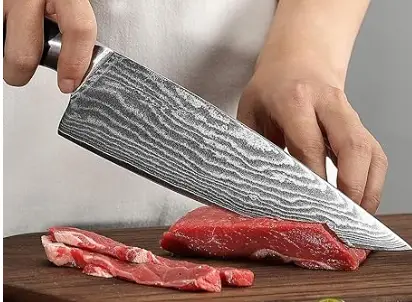Table of Contents
What is AUS 6 steel?
AUS 6 steel is part of the AUS series comprising AUS 4, AUS 6, AUS 8, and AUS 10. It is manufactured in Japan by Aichi steel. AUS 6 contains 0.65% Carbon in its composition, making it low-quality steel used to make cheap low-entry knives.
Also, AUS 6 is stainless steel because it contains 14% Chromium, more than the amount required to make steel stainless. Although low-end steel, AUS 6 knives do not rust easily.
AUS 6 stainless steel is the Japanese equivalent of AISI 440A steel and DSR-1K6 steel. It is also referred to as AUS 6A stainless steel. It was commonly found in CRKT and Kershaw knives but later dropped for cheap and better Chinese steels like 4Cr14 steel, 8Cr13MoV, and 8Cr14MoV steel.
AUS 6 Composition
- Carbon C 0.55%: Increases edge retention, hardness, and tensile strength. It also improves steel resistance to wear, abrasion, and corrosion.
- Chromium Cr 13.00%: Formation of Chromium carbides. Increases the blade’s hardness, tensile strength, and corrosion resistance.
- Vanadium V 0.25%: inhibits grain growth during elevated temperature processing and heat treatment, which enhances the strength and toughness of steel. It also forms carbides that increase wear resistance.
- Nickel Ni 0.49%: improves strength and toughness. It increases hardenability but not as much as some of the other alloying elements in steel. It can enhance corrosion resistance in significant amounts
- Phosphorous P 0.04%: Increases the strength and improves machinability of steel
- Manganese Mn 1.00%: improves the strength and hardness of steel. When the steel is heat-treated, hardenability is improved with increased manganese.
- Silicon Si 1.00%: Increases strength and heat resistance.
- Sulfur S 0.03%: Improves machinability but is regarded as an impurity in high quantities.
AUS 6 Steel Properties
AUS 6 Steel Hardness
AUS 6 has a Rockwell hardness of 55-58HRC. The hardness differs from the heat treatment used by the manufacturer. This hardness level indicates that it is soft steel and, therefore, easy to sharpen and machine. The low hardness is associated with the 0.65% Carbon in its composition.
AUS 6 Steel Wear resistance
The level of wear resistance offered by AUS 6 steel is enough to withstand wear and tear from daily use and sharpening. The relationship between hardness and wear resistance of steel is relative. Therefore, you cannot expect superior wear resistance from AUS 6 because it is milder steel.
Although knives made from this steel can withstand challenging applications, you should not expose them to uses that might deform them. AUS 6 can be used in small blades not subjected to high wear applications.
AUS 6 Steel Edge retention
AUS 6 steel offers decent edge retention, considering its level of hardness and Carbon content in its composition. The blades of AUS 6 knives hold an edge longer than softer steels, but it is not the best out there.
If you are out for a knife that will remain sharp for a long time, look into knives made from steel that contain more carbon than AUS 6 stainless steel. Improved versions of AUS 6 steel like AUS 10 steel will hold an edge for longer.
AUS 6 Steel Toughness
This steel does not offer the best toughness out there, but its level of hardness allows its blades to withstand pressure and impact without breaking and chipping. This decent toughness is expected because it is not very hard steel. Also, the Manganese and Nickel in its composition contribute to the added toughness.
AUS 6A steel can be specifically heat treated to give it higher toughness for outdoor knives; however, AUS 6 blade steel will be outperformed by most high carbon knife steels out there in toughness.
AUS 6 Steel Corrosion resistance
This is one area where AUS 6A performs well. It contains enough chromium 14.50% to make it stainless steel, and therefore it can fight corrosion. AUS 6 stainless steel knives do not rust or stain easily but require proper care and maintenance.
Because of this property, knives made from this steel can be used in wet conditions or outdoor use. The only catch is to ensure that the blades are cleaned and dried after use.
Sharpening AUS 6 Steel
The sharpening of steel is determined by its hardness. Therefore, you can already tell that AUS 6 stainless steel is easy to sharpen because it is soft. You will attain a razor-sharp edge with this steel very fast using simple sharpening tools. This comes as a blessing to inexperienced knife users
AUS 6 steel vs. other steels
AUS 6 vs 440A
These steels are very similar in terms of composition, but 440A performs better generally because it contains more Carbon and Chromium in its composition. The additional Chromium gives 440A better corrosion resistance. It offers better corrosion resistance, edge retention, and wear resistance.
On the other hand, AUS 6, with less carbon and lower hardness, offers better toughness and is easier to sharpen. Either of these steels will give you close to a similar performance; you will not notice much difference between the two.
AUS 6 vs S30V
CPM S30V stainless is premium steel produced by crucible industries; it outshines AUS 6 stainless steel in hardness, corrosion resistance, and wear resistance. S30V stainless steel is made following the crucible CPM process that results in a better fine grain structure; it also contains a higher percentage of carbides in its composition.
Therefore, S30V knives offer better wear resistance and edge retention. However, sharpening them is more challenging; it will be easier to sharpen an AUS 6 steel knife than it will be to sharpen an S30V steel knife. You will also get better toughness with AUS 6 steel, but S30V is a better choice in most aspects.
AUS 6 stainless steel vs 420
AUS 6 steel contains a higher amount of carbon in its composition than 420; this translates to better hardness and wear resistance. The added hardness significantly improves the edge retention of AUS 6A over 420 steel. In addition to the increased carbon, AUS 6 stainless steel also contains additional Chromium, giving it higher corrosion resistance.
AUS 6A stainless steel is more of an equivalent to 440A, an upgraded version 420 steel. It thus outperforms 420 in most aspects apart from ease of sharpening. Their toughness is almost similar, and both will not chip and crack.
AUS 6 vs VG10
VG10 is a premium Japanese stainless steel commonly found in high-end Japanese knives. It is better steel than AUS 6 in almost all performance aspects, including edge retention, wear resistance, corrosion resistance. VG10 steel offers a hardness of more than 60HRC, which gives it excellent edge retention and wear resistance.
The hardness results from a high percentage of carbon and other alloying elements like vanadium. While AUS 6A stainless steel offers moderately high corrosion resistance, it cannot be compared to VG10 stainless steel.
VG10 offers a higher corrosion level like that of premium S90V and S35VN; it contains a high amount of Chromium and additional Cobalt that significantly boosts its corrosion resistance.
You will get a tougher knife blade with AUS 6 steel due to the low hardness. It will also be easier to sharpen an AUS 6 steel knife than it will be to sharpen a VG10 steel knife.
AUS 6 vs AUS 8
Both AUS 6 steel and AUS 8 steel belong to the Japanese AUS stainless steel family. AUS 8 stainless steel is an improved version of AUS 6 stainless steel with a better composition. It contains more carbon elements. The additional Carbon elements form hard carbides that boost its hardness, improving edge retention and wear resistance.
While they both contain the same amount of Chromium, AUS 8 stainless steel knife will offer better corrosion resistance than AUS 6 stainless steel due to the addition of molybdenum in its composition. The improved alloy composition also ensures that AUS 8 steel blade provides better toughness.
Sharpening AUS 6 steel will be easier than sharpening AUS 8, but the difference is minimal and almost unnoticeable. In general, An AUS 8 stainless steel will be a better pick
AUS 6 vs AUS 10
AUS 10 stainless steel is an upgraded version of AUS 8 stainless steel; it is top in the Japanese AUS series. AUS 10 steel contains more carbon elements in its alloy; it also includes additional vanadium than its siblings. These additional elements allow AUS 10 steel to achieve a high hardness level of up to 60HRC.
Due to the high volume of vanadium carbides, AUS 10 steel offers better edge retention and wear resistance than AUS 6 steel. AUS 10 also contains additional Nickel, which boosts its corrosion resistance even at elevated temperatures.
AUS 6 steel offers low hardness compared to AUS 10 steel offers better toughness due to the low Rockwell hardness. AUS 6 Knife will be less prone to chipping and cracking. It will also be much easier to sharpen AUS 6 steel than to sharpen AUS 10 steel.
Is AUS 6 good knife steel?
AUS 6 steel quality is entry-level steel for making low-budget knives. It cannot be compared with midrange or high-end steel. Still, it offers decent edge retention, good wear resistance, decent toughness, great corrosion resistance, and is easy to sharpen. If you are searching for a budget knife, check out the varieties of AUS 6 knives.
Most AUS 6 stainless steel knives are mass-production knives that have been die-cut into blanks rather than forged. This makes them cheap and easily accessible.



